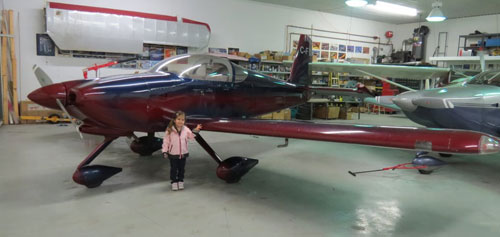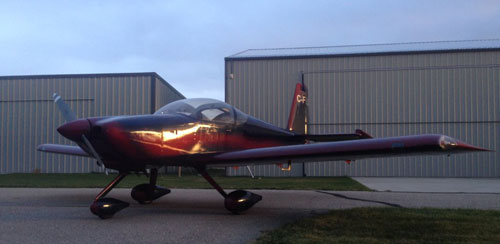Hand-Holding to Handoff: Buying and Selling an Amateur-Built Aircraft
By Donavon Benz, EAA Chapter 1410, EAA 794812
When I met Jean Dueck, she was wearing an EAA T-shirt while providing flu shots in her role as an occupational health nurse. I was in love with Van’s RVs, and she told me she had built a Van’s RV-9A with the tutelage of her husband, Jack – an EAA technical counselor and inspector with the MD-RA (Minister’s Delegate – Recreational Aircraft).
Then, recognizing an aviation addict, Jean said, “We’ve started a small EAA chapter meeting at the airport. Why don’t you come?” I did and soon joined EAA Chapter 1410, ate the delicious chili Jean made for the meetings initially hosted at their hangar, and took the EAA SportAir Workshops sheet metal and electronics courses the chapter coordinated. Then I bought a full standard-build Van’s RV-9 kit in a partnership.
Jean was there to provide support as an EAA technical counselor when we drove our first rivet. Despite a valiant struggle to continue living, Jean sadly succumbed to cancer in 2013. This was the same year the “flood of the century” devastated my home community of High River, Alberta.
My partner Ed and I had made slow progress on our kit, eventually completing the empennage ready for pre-closure inspection and making limited progress on our fuselage. However, what became clear to me after Jean’s death, the flood, and my mother also dying at age 97 near the end of 2013 was that life is not just theoretically finite; it was finite, and I was now 66 years old. Finishing the kit at our pace was years away, by which time I might not even be medically fit to fly.
Selling BJJ
By Jack Dueck – Chairman, EAA Canadian Council, EAA 337912
C-FBJJ really was Jean’s aircraft; a beautifully crafted Van’s RV-9A. Jean loved building it and then flying it. Her approach to flying was like any other challenge she faced: research, evaluate, learn from others, and finally, set up a thorough checklist and not rely on memory. Nothing careless or rushed. In fact, to advance her flying skills, she booked a number of hours with Sean D. Tucker’s flight school, flying a Pitts in any number of unusual attitude recoveries as well as aerobatic flight.
Jean put about 440 hours on BJJ before she passed away. Somehow, I couldn’t get myself to fly BJJ after that. It always felt like I was trespassing on hallowed territory. So, having two aircraft, I decided to sell BJJ.
Donavon Benz had asked for first dibs, so I mentioned to him that I would consider selling her. The rest is history. Suffice to say that I was not prepared to sell an amateur-built aircraft to someone that I didn’t believe was responsible and would carry on BJJ’s flight hours with the care and due diligence necessary. I was acquainted with a friend’s disastrous legal battle after selling his Pitts. My knowledge and respect for Donavon mitigated these concerns, and together with a “hold harmless” sales agreement, the aircraft passed ownership to him.
Jack was devastated by Jean’s death. I knew they had plans to take many trips in Jean’s beautifully painted purple and maroon RV-9A, C-FBJJ, that now were not to be. Subsequently I became aware that Jack was reluctantly considering the sale of the plane. Earlier I had told Jack that if he ever wanted to sell Jean’s 9A to give me the first option.
Jack took a while and then finally called me, saying he didn’t need two airplanes. (He has a great old Luscombe.) I bought BJJ “as is” from Jack on January 1, 2014, signing EAA’s recommended sales agreement that holds Jack harmless should something break on BJJ, or the more likely scenario, should I break it and someone got injured or killed.
Ed also wanted a share in BJJ and we were both giddy with excitement – and for me a little scared about what I had just done. Scared not for spending a substantial amount of money on the purchase but rather for recognizing that, despite previously taking the very comprehensive EAA SportAir Annual Inspection Course, I had a very loose grasp on what would be involved in keeping BJJ both airworthy and legal. I had one thing that kept my fear from becoming disabling: a good relationship with the very knowledgeable, ethical, and supportive seller.
Some things which arose from the sale were just the “Now what?” change in registration with Transport Canada and the arrangement for insurance. Jack encouraged me to consider EAA’s C-Plan as its introduction into Canada that had brought new competitiveness into the market, and I can say I have found their service to be excellent. The insurer did insist that Ed and I get 10 hours each with a qualified instructor before we would qualify for insurance - which we did. But before that happened...
C-FBJJ had fuel leaking from both tanks at the time of purchase. Jack helped to remove them – a certainly doable but not an insignificant challenge – and then they were taken to Ralph Inkster at Custom Aircrafters in Springbank where he found that a part of the tank sealant had for some reason never set up properly. The old sealant had to be removed and replaced. That done, Jack assisted us in reinstalling the tanks, and he paid for the repair, asking nothing from us as purchasers of the aircraft. He also assisted with adding nose gear and tail-strengthening modifications from Anti Splat Aero, which we added in the hope that if we ever mishandled our beautiful bird, these might just make the difference in keeping us from being badly bloodied or worse.
Close on the heels of the tank repair came our first annual inspection. While we had the comprehensive checklist for BJJ put together by Philip Ward, an AME and instructor for EAA’s SportAir Annual Inspection Course, Jack assisted and oversaw the actual hands-on removal of panels, looking for metal fatigue and loose fasteners; lubricating the hinges; checking the propeller; cleaning and lubricating wheel bearings; checking the landing gear and tires; removing, cleaning, and reinstalling spark plugs and the carburetor air filter; checking cylinder compression; and changing the oil and filter. Jack’s involvement was invaluable.
Jack also assisted in changing the static ports to the standard location recommended by Van’s, as he had found BJJ’s autopilot to be hunting in altitude hold with a nonstandard static port installed on BJJ’s pitot tube. Further, he put us in touch with Philip Ward who after working on “big birds” fortunately likes being involved with the homebuilding community. For lunch and reimbursement of his travel expenses, he assisted us for the better part of a day in chasing down and eliminating an electrical glitch that had been causing radio interference, a repair much appreciated.
Jack has remained available to assist with numerous questions and the odd repair that has arisen since the first annual inspection. One example is removing the oil filler tube, building a suitable gasket seal, then reinstalling and safetying it to fix a small oil leak from the base of the oil filler tube.
So now, 15 months after Jack sold us the aircraft, Ed and I feel much more confident about undertaking the maintenance of this aircraft on our own. While there will inevitably be other questions and problems which will arise and for which we will seek hard-earned knowledge from Jack and others in the aviation maintenance community, I think we are now qualified to “go solo” in much the same way a pilot earns the right to solo an aircraft.
Finally, I would comment on the liability we all face when it comes to the sale or ownership of amateur-built aircraft. While the EAA “hold harmless” agreement signed in good faith by both Jack and I would no doubt serve as some protection for Jack should BJJ be involved in an accident, as I understand the law, none of us can sign away our legal rights. The courts in Canada, again as I understand it, in determining whether or not there is culpability for negligence of some sort, look at whether or not due diligence was employed in reducing risk, recognizing that eliminating risk is not possible.
In my judgment, Jack has certainly met the standard of being diligent in ensuring that as the buyer I am up to speed in not only what constitutes the minimum legal maintenance requirements for ensuring BJJ remains airworthy, but he has deepened both my and my partner’s understanding of what constitutes excellent maintenance, too. So now, should one of our relatives seek to sue Jack for some perceived “error of omission” if BJJ comes apart because Ed or I run her into a thunderstorm or the side of a mountain, they will have a hard time making the case that he did not show “due diligence” in selling, and more importantly, “handing off” this aircraft.

In conclusion, I would recommend that both seller and buyer of homebuilt aircraft should build in a joint annual inspection prior to hand-off as part of their sales agreement and sign the inspection checklist as having been completed. Although the new owner is legally responsible for maintenance of the aircraft, I believe a joint annual inspection as part of the sale protects both the seller and the buyer from potential liability. Third parties who might try to claim that either seller or buyer did not show due diligence in ensuring knowledgeable and thorough maintenance continues in changing ownership of the aircraft would be hard-pressed to make their case before the courts.
Checklist
1. Negotiate an acceptable price for both the seller and the buyer. This maintains goodwill on the part of both parties.
2. In selling the aircraft “as is”, if the seller determines that an item prevents the aircraft from being airworthy at the point of sale, then seller should put it right as part of the sale price (unless the “as is” makes a specific reference to the deficiency as part of the sales agreement).
3. Ensure the handoff to the buyer includes a joint annual inspection of the aircraft and jointly sign it off. The buyer is advised to make clear and comprehensive notes or a video record of the aircraft’s annual inspection for future reference. Things which seem straightforward and understandable when the former owner is present will not be so straightforward weeks or often months later. The seller also should provide the buyer with the aircraft’s construction plans along with service manuals for its particular instrumentation and avionics.
4. If, after taking ownership of the aircraft, you find something has arisen which needs maintenance attention, and if how best to proceed is unclear, the buyer can seek guidance from the seller. If you have established a good relationship with the seller, you might even receive the gift of hands-on assistance.
5. Finally, enjoy the satisfaction of maintaining your own aircraft. The knowledge gained will not only increase the safety of your flight, but it will put more “fun tickets” in your wallet to spend on flying, too.

